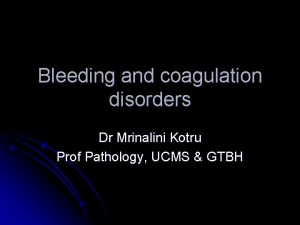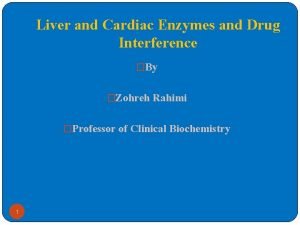Prolonged fever is defined as fever more than







































- Slides: 39




Prolonged fever is defined as fever more than 2 weeks duration greater than 38. 3◦C (101◦F) on several occasions. The causes of prolonged fever are classified in to 4 major groups: • infections (most common cause). • non-infectious inflammatory diseases (NIID). • malignancies. • miscellaneous conditions.

Infection is the most common diagnosis in most cases of prolonged fever especially in developing countries which include: • Bacterial (salmonellosis , tuberculosis , brucellosis, and abdominal or pelvic abscesses , osteomyelitis, infective endocarditis, Pyelonephritis tuberculous meningitis ). • Viral (CMV, EBV, Herpes viruses , and HIV). • Rickettsial (Q fever). • Parasitic infections. and

• The common infections in Egypt causing prolonged fever that we will study in this essay as regard the diagnosis serology are: • salmonellosis , • tuberculosis(TB) , • brucellosis, • Q fever, • Epstein-Barr virus (EBV), • chronic meningitis. especially the

Common infections causing prolonged fever in Egypt

Mal-treated typhoid fever -Typhoid fever (enteric fever) is caused by the Gram-negative bacterium Salmonella enterica serotype typhi. -Estimates for the year 2000 suggest there approximately 21. 5 million infections and 200, 000 deaths from typhoid fever globally each year. -The clinical manifestations of typhoid fever are usually nonspecific, and include prolonged fever and gastrointestinal symptoms.

Typhoid fever in Egypt -In Bilbeis district (population 664, 000) in Lower Egypt the estimated incidence of typhoid fever was calculated to be 13 cases per 100, 000 persons per year. -Also the results of population-based surveillance in Fayoum governate indicate that incidence of typhoid fever was 59 cases per 100, 000 persons per year.

Brucellosis -The causative agent is Brucella spp. , ( Gramnegative intracellular coccobacillus discovered by David Bruce in 1887). -Brucellosis is a relatively common condition and may present with prolonged fever without a focus, however due its wide spectrum of clinical symptoms it remains an important diagnostic challenge. -It is a zoonotic disease found worldwide, with a high morbidity rate.

Brucellosis in Egypt -Brucellosis is endemic in the middle East. -In Egypt 11% of the population had serological evidence of infection with Brucella spp. , while in acute febrile illnesses 3% of all bacteraemias were caused by the organism. -Although brucellosis is recognized as a common cause of fever in various parts of Egypt, it is often misdiagnosed and mistreated. -More than half of all brucellosis cases were misdiagnosed as typhoid, and only a quarter of them received treatment with more than one antibiotic.

Tuberculosis -Tuberculosis is caused by Mycobacterium tuberculosis complex (MTBC). -Tuberculosis may involve every organ in the body but the most common clinical presentation is pulmonary disease. -In 2006, 9. 2 million new active disease cases (4. 1 million being sputum smear-positive) corresponding to an estimated incidence of 139 per 100, 000 population occurred throughout the world. -The highest incidence rate was recorded for the African region , mainly due to high prevalence of HIV infection.

Tuberculosis in Egypt According to a 1997 report from the Egyptian National Tuberculosis Program, revealed that the incidence of smear-positive cases in Egypt is 16 per 100, 000 population, This report concluded that TB and especially drug-resistant strains of Mycobacterium tuberculosis pose serious public health problems and that multiple drug resistance and low cure rates are the most important problems facing TB control efforts in Egypt.

Qfever Q fever is a widespread zoonotic disease, caused by Coxiella burnetii (C. burnetii). Wild and domestic animals are the reservoir of C. burnetii, It is a zoonosis occurring worldwide. Q fever is associated with a wide spectrum of clinical manifestations. In most cases, this illness has a selflimiting febrile course, but it may also manifest with a variety of non-specific symptoms. As with most other rickettsioses, Q fever is infrequently suspected and remain unrecognized.

Infectious mononucleosis *The clinical triad of pharyngitis, fever, and lymphadenopathy was first described as “glandular fever, ”. *IM is caused by the Epstein Barr virus (EBV), which infects more than 98% of the world’s adult population. *The overall clinical incidence is 45/100 000 and it is particularly common in adolescence. *IM is a clinical syndrome characterized by fever, fatigue, malaise, lymphadenopathy and sore throat.

Chronic meningitis -Chronic meningitis is defined by persistent or clinically progressive signs and symptoms of meningitis, such as headache, fever, stiff neck, nausea, vomiting, lethargy, and confusion associated with cerebrospinal fluid (CSF) changes lasting for a duration of at least 4 weeks without improvement.

-Chronic meningitis is caused by a wide variety of infectious and noninfectious pathogens that remain difficult to diagnose. In Egypt, Tuberculous meningitis (TBM) being one of the most common causes of bacterial meningitis and being associated with a high mortality (47%) and it continues to be a significant public health problem.


Typhoid fever diagnosis Although the mainstay of diagnosing typhoid fever is a positive blood culture it is time-consuming and takes at least 2 to 5 days until the identification of the organism. PCR is a better alternative because it is sensitive and rapid method. PCR-based diagnoses are superior to the classical serological method, Widal test, and blood culture test in terms of their specificity and sensitivity. Nested PCR had higher efficacy in detecting typhoid fever than Widal test, blood and urine cultures.

Brucella diagnosis Isolation of brucella from blood, bone marrow, lymph nodes or cerebrospinal fluids remains the gold-standard for diagnosis of brucellosis in humans. Despite its high specificity, brucella culture has several drawbacks such as slow growth and poor sensitivity. PCR proved to be a very useful tool not only for the diagnosis of acute brucellosis but also as a predictive marker for the course of the disease and the post treatment follow-up, which is valuable for the early detection of relapses.

Tuberculosis (TB) diagnosis Microscopy is still the backbone of laboratory diagnostics in TB. Many nucleic acid amplification methods are much more sensitive than sputum microscopy, and results can be available within several hours. The cost and complexity of existing nucleic acid amplification methods has limited their application in resource-poor settings. Transrenal DNA provides a challenging new target for molecular tuberculosis diagnosis in all groups of patients.

Q Fever diagnosis The isolation of the Q fever pathogen is a reliable diagnostic method, but it remains timeconsuming and hazardous and requires biosafety. The PCR assays performed are better tests than pathogen isolation for the rapid and reliable diagnosis of Q fever.

Infectious mononucleosis diagnosis Quantitative Epstein bar virus (EBV) DNA measurement is essential for differentiating the low -level infection of healthy carriers from the high levels characteristic of EBV-related disease. Realtime PCR is the principal technology used for modern EBV viral load measurement.

Chronic meningitis The identification of meningitis etiology is primarily based on the examination of CSF and other tissues, which includes direct stain, cultures on aerobic, anaerobic media. However, even with the use of modern techniques, the etiology of chronic meningitis remains unknown in a substantial percentage of patients. The CSF polymerase chain reaction (PCR) assay represents a significant advance in the diagnosis of TBM. The results of PCR studies in the CSF have shown a 94— 100% specificity but sensitivities ranging from 75% to 100%. CT and MRI are used in the evaluation of TBM and to identify complications.


Maltreated Typhoid fever The most widely used serologic test is the Widal test, However, false-positive results are common because of antigenic cross sharing with other salmonella serotypes. Several new serologic tests for typhoid fever have been introduced which detect Ig. M or Ig. G antibodies to various purified antigens of S. Typhi. The assay methods used include enzymelinked immunosorbent assay (ELISA), dot-blot ELISA, immunochromatography and a novel particle separation method used in TUBEX. The TUBEX test is simple and rapid to use not only in hospitals but also for outpatients as well. It is good alternative for widal test.

Typhidot-M is a dot enzyme immunoassay for the detection of specific Ig. M to Salmonella typhi. Typhidot-M was positive in 97% of cases who presented with fever of <7 days among blood culture positives as compared to Widal, which was positive in 24. 2%. It is a dot-Enzyme Immunoassay (EIA), a new serologic test based upon the presence of specific Ig. M antibodies to a specific 50 k. Da outer membrane protein (OMP) antigen on Salmonella typhi. The test become positive as early as in the first week of the fever, the results can interpreted visually and available within one hour

Brucellosis Serological testing often is used for the confirmation of brucellosis. The agglutination tests in tubes, e. g serum agglutination test (SAT), or on slides (Rose Bengal) continue to be the mainstay of laboratory diagnosis. . However, SAT and the other formats of direct agglutination tests suffer from high false negative rates in complicated and chronic cases ELISA is one method that has been incorporated into serologic diagnosis of brucellosis. Among its advantages are speed and automatization. ELISA also allows detection of antibodies against different bacterial antigenic structures such as corpuscular antigen, S-LPS or protein antigens.

Tuberculosis The detection of circulating mycobacterium antigens using specific monoclonal antibodies (m. Abs) has been shown to be a promising approach to the detection of active infection. Recently, developed a simple and rapid dot- ELISA test based on Ig. G monoclonal antibody (TB-55 m. Ab) specific for a 55 -k. Da mycobacterial antigen and had been evaluated in the diagnosis of pulmonary as well as extrapulmonary TB.

The gold-standard screening method for LTBI is the tuberculin skin test (TST). The TST has several limitations, including the need for repeat visits and trained staff in addition to limited validity of the results. T-cell–based interferon-γ release assay are whole-blood enzyme-linked immunosorbentassay (ELISA) and enzyme linked immunospot assay(ELISpot). The whole blood ELISA is available commercially as Quanti. FERON-TB Gold an “intube” variant, Quanti. FERON-TB Gold In-tube. This T -cell-based assay for diagnosing tuberculosis infection gave promising results.

Q fever Human Q fever is currently diagnosed by clinical presentation and supporting serological responses against fixed, whole-cell phase I and phase II forms of the C. burnetii. The serological testing include immunofluorescence, complement fixation, enzyme- linked immunosorbent assay (ELISA) and microagglutination. Q fever Ig. G ELISA is a specific alternative method for prevaccination testing and the diagnosis of Q fever. Worldwide, the most common method used in human diagnosis of Q fever is the indirect immunofluorescence antibody (IFA).

Infectious mononucleosis Detection of Ig. M antibody against the virus capsid antigen (VCA) is the best approach for the identification of primary EBV infection. Indirect immunofluorescence assay (IFA) of anti-VCA Ig. M and Ig. G antibody has been regarded as the golden standard for the serological diagnosis of EBV infection, and other methods, such as enzyme -linked immunosorbent assays (ELISA) and chemiluminescent immunoassay (CLIA), were developed to improve the assay procedure.

Tuberculous meningitis Immunological methods such as antibody-capture enzyme-linked immunosorbant assay (ELISA) have been previously used for diagnosing TBM. The cell ELISA method allows further confirmation of the results obtained by antibody-capture ELISA. The presence of a 30 -k. D protein antigen in CSF of TBM patients indicates that this protein carries the candidate marker antigen which is specific to M. tuberculosis.


Statistical comparisons for cases of typhoid from 2003 to 2008 admitted in Mansoura fever hospital

Statistical comparisons for cases of brucella from 2003 to 2008 admitted in Mansoura fever hospital

Statistical comparisons for cases of tuberculosis from 2003 to 2008 admitted in Mansoura fever hospital

Statistical comparisons for cases of meningitis from 2003 to 2008 admitted in Mansoura fever hospital

 Lirik lagu more more more we praise you
Lirik lagu more more more we praise you More more more i want more more more more we praise you
More more more i want more more more more we praise you Prolonged pt
Prolonged pt Pt aptt
Pt aptt Template method for bleeding time
Template method for bleeding time Stages of normal labour
Stages of normal labour Prolonged first stage
Prolonged first stage Whats an extended metaphor
Whats an extended metaphor Greater than god more evil than the devil
Greater than god more evil than the devil More er than
More er than Half life more than 2 less than 4
Half life more than 2 less than 4 A collection of well defined objects
A collection of well defined objects Greater than less than fractions
Greater than less than fractions Compound inequality definition
Compound inequality definition Fraction odd one out
Fraction odd one out Inequality key words
Inequality key words Your love is deeper than the ocean higher than the heavens
Your love is deeper than the ocean higher than the heavens Percent greater than 100 and less than 1
Percent greater than 100 and less than 1 Dot
Dot Supplementlet
Supplementlet Paradigms for interaction
Paradigms for interaction Why are related forms more agreeable than unrelated forms
Why are related forms more agreeable than unrelated forms My vegetable love should grow
My vegetable love should grow Basicity of arylamines
Basicity of arylamines Is oil more dense than water
Is oil more dense than water Technical terms in research
Technical terms in research To describe a position in more than one dimension
To describe a position in more than one dimension On the eve of world war i, bosnia was ruled by *
On the eve of world war i, bosnia was ruled by * R v millard and vernon
R v millard and vernon Apa in text citation multiple authors first time
Apa in text citation multiple authors first time Beneath this mask v for vendetta
Beneath this mask v for vendetta Melissa dobbins chocolate milk
Melissa dobbins chocolate milk Why are related forms more agreeable than unrelated forms
Why are related forms more agreeable than unrelated forms At stp which gas will diffuse more readily than ne
At stp which gas will diffuse more readily than ne Why does new guinea have more species of birds than bali?
Why does new guinea have more species of birds than bali? Ast more than alt
Ast more than alt Nothing is more precious than happiness and health.
Nothing is more precious than happiness and health. Somatic cells vs germ cells
Somatic cells vs germ cells Meherjan passage bangla meaning
Meherjan passage bangla meaning A picture paints a thousand words
A picture paints a thousand words




























































